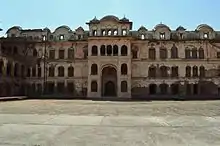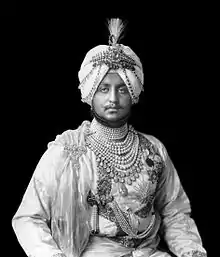State of Patiala | |||||||||||||||||||
|---|---|---|---|---|---|---|---|---|---|---|---|---|---|---|---|---|---|---|---|
| 1763–1947 | |||||||||||||||||||
 Coat of arms
| |||||||||||||||||||
| Capital | Patiala | ||||||||||||||||||
| Common languages | Punjabi (official) | ||||||||||||||||||
| Religion | Sikh | ||||||||||||||||||
| Government | Absolute monarchy | ||||||||||||||||||
| Maharaja | |||||||||||||||||||
• 1707 - 1765 | Ala Singh | ||||||||||||||||||
• 1938 - 1947 | Yadavindra Singh | ||||||||||||||||||
| History | |||||||||||||||||||
• Established | 1763 | ||||||||||||||||||
• Disestablished | 1947 | ||||||||||||||||||
| Area | |||||||||||||||||||
• Total | 15,389 km2 (5,942 sq mi) | ||||||||||||||||||
| Population | |||||||||||||||||||
• 1881[1] | 1,467,433 | ||||||||||||||||||
• 1891[1] | 1,583,521 | ||||||||||||||||||
• 1901[1] | 1,596,692 | ||||||||||||||||||
| Currency | Rupee And Paisa | ||||||||||||||||||
| |||||||||||||||||||
| Today part of | India Pakistan | ||||||||||||||||||
Patiala State was a self-governing princely state of the Empire of India, and one of the Phulkian States, that acceded to the Union of India upon Indian dominionship and partition. Patiala Kingdom/State was founded by Sidhu Jat Sikhs.
Early proposals of a Sikh nation of ‘Sikhistan’ led by Maharaja of Patiala were published by Dr VS Bhatti in 1940 for a “Khalistan led by the Maharaja of Patiala with the aid of a cabinet consisting of representative federating units”.[2][3][4][5] These would consist of the central districts of Punjab province then directly administered by the British, including Ludhiana, Jalandhar, Ambala, Ferozpur, Amritsar and Lahore; the 'princely states' of the Cis-Sutlej, including Patiala, Nabha, Faridkot and Malerkolta; and the 'Shimla Group' of states. After partition of India in 1947, The Liberator, a Sikh publication advocated for Khalistan which would include East Punjab merged with PEPSU led by Maharaja of Patiala as its monarch.[6]
Etymology
The state's name came from the name of its principal city and capital, Patiala, which itself comes from the roots patti and ala. The word patti means "strip of land" in Punjabi, and 'ala' comes from the name of the founder of the city and Patiala state, Ala Singh, thus meaning ‘the land of Ala Singh’ [7]

Brief history
| History of India |
|---|
 |
| Timeline |
In 1763, the Sikh confederation captured the fortress of Sirhind
Rulers
The rulers of Patiala bore the title 'Maharaja-e Rajgan' from 1810 onward.
Maharajas
- 29 Mar 1761 – 22 August 1765: Ala Singh (b. 1691 – d. 1765)
- 22 Aug 1765 – 1767:Amar Singh (b. 1748 – d. 1781)
Raja-e Rajgan
- 1767 – 5 February 1781: Amar Singh (s.a.)
- Feb 1781 – 1810: Sahib Singh (b. 1774 – d. 1813)
Maharaja-e Rajgan
- 1810 – 26 March 1813: Sahib Singh (s. a.)
- 26 Mar 1813 – 23 December 1845: Karam Singh (b. 1797 – d. 1845)
- 26 Mar 1813 – 1823: Maharani Aus Kaur (f) – Regent (b. 1772 – d. af.1823)
- 23 Dec 1845 – 13 November 1862: Narendra Singh (b. 1823 – d. 1862) (from 25 June 1861 Sir Narendra Singh)
- 13 Nov 1862 – 14 April 1876: Mahendra Singh (b. 1852 – d. 1876) (from 28 May 1870 Sir Mahendra Singh)
- 13 Nov 1862 – 26 February 1870: Jagdish Singh (Regent, chairman of regency council)
- 14 Apr 1876 – 9 November 1900: Rajinder Singh (b. 1872 – d. 1900) (from 21 May 1898 Sir Rajendra Singh)
- 14 April 1876 – Oct 1890: Sir Deva Singh (Regent) (b. 1834 – d. 1890) (chairman of regency council)
- 9 November 1900 – 23 March 1938: Bhupinder Singh (b. 1891 – d. 1938) (from 12 December 1911 Sir Bhupindra Singh)
- 9 November 1900 – 3 November 1910: Sardar Gurmukh Singh – (Regent, chairman of regency council)
- 23 Mar 1938 – 15 August 1947: Yadavindra Singh (b. 1913 – d. 1974) (from 1 January 1942 Sir Yadavindra Singh)
Demographics
Religion
| Religion | Population | Percentage |
|---|---|---|
| Sikhism |
896,021 | 46.28% |
| Hinduism |
597,488 | 30.86% |
| Islam |
436,539 | 22.55% |
| Christianity |
1,412 | 0.07% |
| Others[lower-alpha 2] | 4,799 | 0.25% |
| Total Population | 1,936,259 | 100% |
Gallery
 Sardar Jassa Singh Ramgarhia on left and Amar Singh of Patiala on right, late 18th century
Sardar Jassa Singh Ramgarhia on left and Amar Singh of Patiala on right, late 18th century Miniature painting of Raja Amar Singh of Patiala, ca.1830
Miniature painting of Raja Amar Singh of Patiala, ca.1830 Moti Bagh Palace, Patiala.
Moti Bagh Palace, Patiala. The main gate of the Qila Mubarak
The main gate of the Qila Mubarak Maharaja Bhupinder Singh of Patiala
Maharaja Bhupinder Singh of Patiala
 Maharaja Rajinder Singh of Patiala
Maharaja Rajinder Singh of Patiala A panel of seven portraits of rulers of Patiala State
A panel of seven portraits of rulers of Patiala State Detail of an informal visit at Moti Bagh Palace from an album of photographs compiled by the wife of Dr. H.R. Hunter during his time as Dental Surgeon at Moti Bagh Palace during the reign of Maharajah Bhupinder Singh, circa 1922–23
Detail of an informal visit at Moti Bagh Palace from an album of photographs compiled by the wife of Dr. H.R. Hunter during his time as Dental Surgeon at Moti Bagh Palace during the reign of Maharajah Bhupinder Singh, circa 1922–23
See also
Notes
- ↑ Including Ad-Dharmis
- ↑ Including Jainism, Buddhism, Zoroastrianism, Judaism, Tribals, others, or not stated
References
- 1 2 3 Imperial gazetteer of India. Vol. XX Pardi to Pusad. 1908. pp. 40, 42.
- ↑ Shani, Giorgio (2007). Sikh Nationalism and Identity in a Global Age. doi:10.4324/9780203937211. ISBN 9781134101894.
- ↑ Shani, Giorgio (6 December 2007). Sikh Nationalism and Identity in a Global Age. Routledge. ISBN 978-1-134-10188-7.
- ↑ Archives, The National. "The National Archives - Homepage". The National Archives. Retrieved 14 October 2022.
- ↑ Pathak, Ritika (12 December 2020). "Khalistan movement: Origin and the two different narratives". Newshour Press. Retrieved 14 October 2022.
- ↑ Singh, Amar. "Let Patiala Lead The Panth To Glory". National Achieves UK.
- ↑ Kaur, Roopam Jasmeet; Idris, Mohammad (2011). "The Development of Education in Patiala District (1948-2001): A Gendered Analysis". Proceedings of the Indian History Congress. 72: 1460–1470. JSTOR 44145757.
- ↑ "Census Of India, 1941 Volume VI Punjab Province". Retrieved 17 January 2023.
Further reading
- Chavan, Akshay (15 February 2019), "Hitler's Gift to The Maharaja of Patiala", Live History India
- Dhavan, Purnima (2011). When Sparrows Became Hawks: The Making of the Sikh Warrior Tradition, 1699-1799. Oxford University Press (US). ISBN 978-0199756551.
- Priscoli, Jerome Delli; Wolf, Aaron T. (2010). Managing and Transforming Water Conflicts. Cambridge University Press. ISBN 978-0521632164.
